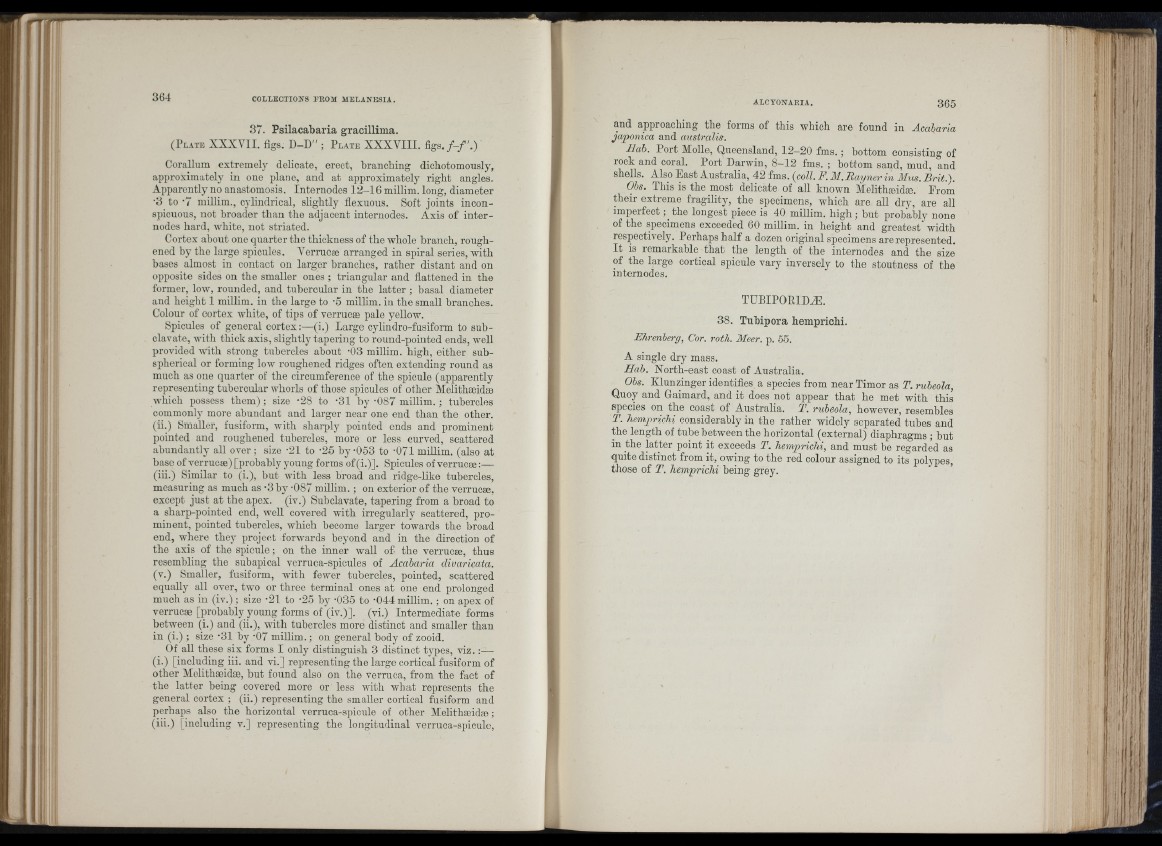
37. Psilacabaria gracillima.
( P la t e XXXVII. figs. D -D ” ; P l a t e XX XV III. f ig s ./ - / ”.)
Corallum extremely delicate, erect, branching dichotomously,
approximately in one plane, and at approximately right angles.
Apparently no anastomosis. Internodes 12-16 millim. long, diameter
•3 to -7 millim., cylindrical, slightly flexuous. Soft joints inconspicuous,
uot broader than the adjacent internodes. Axis of in te rnodes
hard, white, uot striated.
Cortex about one quarter the thickness of the whole branch, roughened
by the large spicules. Verrucæ arranged in spiral series, w ith
bases almost in contact on larger branches, rather distant and on
opposite sides on the smaller ones ; triangular and flattened in the
former, low, rounded, and tubercular in the latter ; hasal diameter
and height 1 millim. iu the large to -5 milhm. in the small branches.
Colour of cortex white, of tips of verrucæ pale yellow.
Spicules of general cortex:—(i.) Large cylindro-fusiform to suh-
clavate, with thick axis, slightly tapering to round-pointed ends, well
provided with strong tubercles about -03 millim. high, either sub-
spherical or forming low roughened ridges often extending round as
much as one quarter of the circumference of the spicule (apparently
representing tubercular whorls of those spicules of other Melithæidæ
which possess them) ; size -28 to -31 by -087 millim. ; tubercles
commonly more abundant and larger near one end than the other,
(ii.) Smaller, fusiform, with sharply pointed ends and prominent
pointed and roughened tubercles, more or less curved, scattered
abundantly all over ; size -21 to -25 by -053 to -071 miUim. (also at
base of verrucæ) [probably young forms of (i.)]. Sjiicules of verrucæ :—
(iii.) Similar to (i.), but with less broad and ridge-like tubercles,
measuring as much as *3 by '087 millim. ; on exterior of the verrucæ,
except ju st a t the apex, (iv.) Subclavate, tapering from a broad to
a sharp-pointed end, well covered with irregularly scattered, prominent,
pointed tubercles, which become larger towards the broad
end, where they project forwards beyond and in the direction of
the axis of the spicule ; on the inner wall of the verrucæ, thus
resemhliug the subapical verruca-spicules of Acaharia divaricata.
(v.) Smaller, fusiform, with fewer tubercles, pointed, scattered
equally all over, two or three terminal ones at one end prolonged
much as iu (iv.); size -21 to -25 by -035 to -044millim. ; on apex of
verrucæ [probably young forms of (iv.)]. (vi.) Intermediate forms
between (i.) and (ii.), with tubercles more distinct and smaller than
in (i.) ; size -31 by '07 millim. ; on general body of zooid.
Of all these six forms I only distinguish 3 distinct types, viz. :—
(i.) [including iii. and vi.] representing the large cortical fusiform of
other Melithæidæ, but found also on the verruca, from the fact of
the latter being covered more or less with what represents the
general cortex ; (ii.) representing the smaller cortical fusiform and
perhaps also the horizontal verruca-spicule of other Alelithæidæ,;
(iii.) [including v.] representing the longitudinal verruca-spiculc.
and approaching the forms of this which are found in Acaharia
japónica and australis.
Hab. Port Molle, Queensland, 12-20 fms. ; bottom consisting of
rock and coral. Port Darwin, 8 -1 2 fms. ; bottom sand, mud, and
shells. Also East Australia, 42 fms. {coll. E M.Rayner in Mus. B rit.).
Ohs. This is the most delicate of all known Melithæidæ. From
their extreme fragility, the specimens, which are all dry, are all
imperfect ; the longest piece is 40 millim. high ; but probably none
of the specimens exceeded 60 millim. in height and greatest width
respectively. Perhaps half a dozen original specimens are represented.
I t is remarkable th at the length of the internodes and the size
of the large cortical spicule vary inversely to the stoutness of the
internodes.
TUBIPORIDÆ.
38. Tubipora hemprichi.
Ehrenherg, Cor. roth. Meer. p. 55.
A single dry mass.
Hah. Xorth-east coast of Australia.
Obs. Klunzinger identifies a species from near Timor as T. rubeola,
Quoy and Gaimard, and it does not appear th at he met with this
species on the coast of Australia. T. rubeola, however, resembles
T. hemprichi considerably in the rather widely separated tubes and
the length of tube between the horizontal (external) diaphragms ; hut
in the latter point it exceeds T. hemprichi, and must be regarded as
quite distinct from it, owing to the red colour assigned to its polypes,
those of T. hemprichi being grey. ’